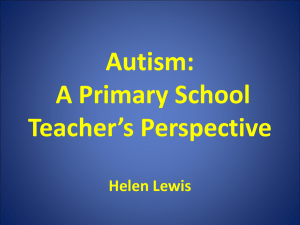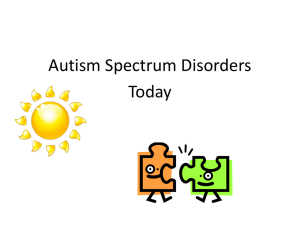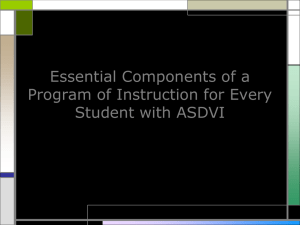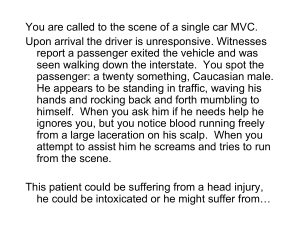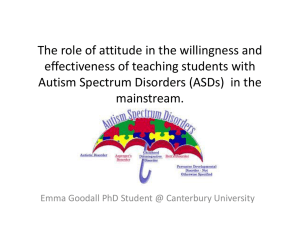Mental Illness in Adults with Autism Spectrum Disorder: Preliminary
advertisement
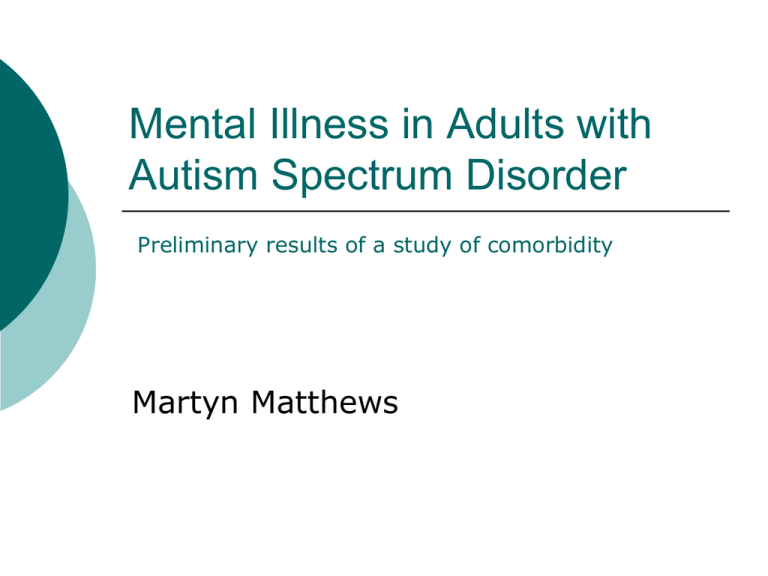
Mental Illness in Adults with Autism Spectrum Disorder Preliminary results of a study of comorbidity Martyn Matthews What we know so far Around 90% of ASD research is about children Most adult ASD research is about problem behaviour A few studies have identified that adult outcomes are negatively influenced by mental health problems (Howlin 2009) Very little research has looked at the mental health of adults with ASD Confusion What are core features of ASD vs. comorbid disorders? How can we make a clear assessment or diagnosis (tools & knowledge) whether the usual treatment/intervention work for people with ASD Conflict Who should provide or pay for services Getting access to inpatient mental health services (getting past the gatekeeper) Behaviour of people with ASD in mental health settings So what does the evidence tell us? Anxiety Disorders • Anxiety seems to be a key feature of ASD, but we don’t have strong research evidence for this notion • But, case study evidence suggests a 100% prevalence! However, Only one well designed prevalence study has been done by Szatmari et al (2000). • 13.6% ( 8 out of a group of 59 teenagers with AS or HFA) had anxiety at a level that met DSM IV diagnostic criteria. • Rates for general population are 35% DSM IV Generalised Anxiety Disorder A. At least 6 months of "excessive anxiety and worry" about a variety of events and situations. Generally, "excessive" can be interpreted as more than would be expected for a particular situation or event. Most people become anxious over certain things, but the intensity of the anxiety typically corresponds to the situation. B. There is significant difficulty in controlling the anxiety and worry. If someone has a very difficult struggle to regain control, relax, or cope with the anxiety and worry, then this requirement is met. C. The presence for most days over the previous six months of 3 or more (only 1 for children) of the following symptoms: 1. Feeling wound-up, tense, or restless 2. Easily becoming fatigued or worn-out 3. Concentration problems 4. Irritability 5. Significant tension in muscles 6. Difficulty with sleep D. The symptoms are not part of another mental disorder. E. The symptoms cause "clinically significant distress" or problems functioning in daily life. "Clinically significant" is the part that relies on the perspective of the treatment provider. Some people can have many of the aforementioned symptoms and cope with them well enough to maintain a high level of functioning. F. The condition is not due to a substance or medical issue Possible implications It is extremely hard to differentiate between ASD symptoms and an anxiety disorder Low level, generalised anxiety may be a key feature of ASD (85-90%), though this may not be ‘anxiety’ as we currently understand it In some individuals it is a diagnosable comorbid disorder (10-15%) More able people with ASD have higher levels of anxiety (may just be ability to report symptoms) Mood Disorders Depression Case study and clinic population studies indicate that adults with ASD are much more likely to experience depression than the general population: • • Sterling et al (2007), 20/46 (43%) of adults with ASD had symptoms that would meet DSM IV criteria for depression Wing (1984), 10/34 (29%) of young adults with AS had diagnosable depression Rates for general population are 6.8% (NCS-R, 2001) Depression & co-existing disorders Q. In the general population, depression is frequently comorbid with an additional disorder, so is this also true for people with ASD? A. It looks likely, case study descriptions suggest that: As depression worsens, stereotypic or ritualistic behaviour increase to meet OCD diagnostic criteria Or Restlessness and hyperactivity increase to meet ADHD diagnostic criteria Gahaziudin M, Gahaziudin N, Greden J (2002) Bipolar Disorder We know very little: Some case reports Lots of internet forum discussions Little data Psychosis Catatonia has highest prevalence rates of psychotic disorders in adults with ASD. • • Billstedt & Gilberg (2005) 12% (10 of 120) Wing & Shah (2000) 17% (86 of 506) Psychosis Psychotic disorders are rare in people with ASD, despite the fact that autism used to be classified as a psychotic disorder Schizophrenia is very rarely diagnosed. • • Billstedt & Gillberg (2005) identified 1 individual from a sample of 120 adults with ASD Volkmar & Cohen (1991) identified 1 adult from a sample of 163 adolescents & adults with ASD Prevalence rate is the same as general population (0.4-0.6%) Psychosis Catatonia DSM IV criteria motor immobility as evidenced by catalepsy (including waxy flexibility) or stupor; excessive motor activity (purposeless, not influenced by external stimuli); extreme negativism (motiveless resistance to all instructions or maintenance of a rigid posture against attempts to be moved) or mutism; peculiarities of voluntary movement as evidenced by posturing, stereotyped movements, prominent mannerisms, or prominent grimacing echolalia or echopraxia So what do we really know? What we know about mental illness in people with ASD, is still “not a lot” What we do know relates mostly to people who are usually described as high functioning Almost nothing about the ‘inner world’ of people with ASD and severe intellectual disability Some Solutions More research! Use screening tools to identify undiagnosed disorders Train support workers to observe for and record information relating directly to mental health of the individual Provide training to mental health services around ASD Otago Study Based in Department of Psychological Medicine, University of Otago. Researchers Martyn Matthews Dr Kumari Fernando Dr Brigit Mirfin-Veitch Aims of study To identify the range of psychiatric disorders experienced by a sample of people with ASD Examine similarities/differences in types of disorder experienced by ID vs Non-ID adults with ASD To compare range and rate of disorders with ID only and general population studies Identify effective treatments & support strategies Identify service gaps & future needs Method 120 individuals 40 with both ID and ASD 40 ASD, no ID 40 ID/No ASD Method Review of service provider & DHB files for individual clinical/diagnostic data Completion of screening tool with key support agent for ID and ID/ASD groups Questionnaire to clinicians gathering data on ASD/no ID group and treatment issues Qualitative interviews re experiences of treatment & support services Psychiatric Screening Process & Tools The REISS Screen for Maladaptive Behaviour (Reiss S, 1988, revised 2009) The ASD-A (Autism Spectrum Disorder Battery-Adult Version), (Matson, J,Terlonge, C & Gonzalez M, 2006) Characteristics 10 adults with ID & ASD 80% male All have 24 hr support 90% take one or more psychoactive medication 7 people have severe or profound intellectual disability 3 have mild to moderate intellectual disability 9 have formal diagnosis of Autistic Disorder 1 has no formal diagnosis, but meets DSM IV criteria for Pervasive Developmental Disorder-Not Otherwise Specified Results 70% of the group had clinically significant scores for anxiety 60% displayed self injurious behaviour 50% had Conduct Problems 40% showed symptoms of depression 30% had clinically significant impulsivity or hyperactivity Overall ASD-CA Scores ASD-CA Comorbidity Scores Shaun Garth 9 8 7 6 5 4 3 2 1 0 Kenny Bede Natalie Depression Hyperactivity Behavioural Excess/Irritabilit y Conduct Problems Anxiety Brian Vince Rachel Wilf Dan Mean Scores (Otago) Clinical Cutoff Mean Scores on ASD-A ASD-A Mean Scores for ASD/ID Group 6 5 4 3 2 1 0 Mean Scores (Otago) Mean Scores (Louisiana) Clinical Cut-off An xie ty Co nd Be uc tP rob Hy ha v i ou lem s pe r ral ac Ex ce ss De pr / Ir tiv ity rita b ilit y es sio n Mean Scores on REISS Screen REISS Comorbidity Mean Scores: ASD/ID group 6 5 Mean Scores (Otago) 4 Mean Scores (Chicago) 3 2 Clinical Cutoff 1 Ag gr e ss iv e Ps Be ha vi o ur yc ho s Pa is D ep ra re no ss ia D io ep n (B re ss eh io ) n ( PD ph y D ep s ) en de PD nt Av oi da nt 0 Be ha vi ou Ps r yc ho sis Pa De r pr an e oi a De ssio n pr ( es Be sio h) n (p PD hy D s) ep en de PD Av nt oi da nt e iv ha v io ur al ep r y sio n ity bi lit tiv ac es yp er D H ty le m s xie rit a ro b /Ir tP uc ce ss Ex on d An 9 8 7 6 5 4 3 2 1 0 Ag gr es s Be C Rachel ASD-CA comorbidity: Rachel Mean Scores Rachel Clinical Cut-off REISS Comorbidity scores: Rachel 9 8 7 6 5 4 3 2 1 0 Mean Scores (Otago) Rachel Clinical Cutoff D id nt an t de s) ) oi a (p hy Av o r s (B eh en n De p PD PD sio ra n n Pa sio es es ep r ep r D io u yc ho si Ps Clinical Cut-off av 2 Be h Mean Scores (Otago) ive ep re ss io n 3 ss lity ity yp er ac tiv D H em s et y /Ir rit ab i es s xc Pr ob l An xi Brian gr e ur al E on du ct 4 Ag Be ha vi o C Brian ASD-CA comorbidity: Brian 7 6 5 1 0 Reiss Comorbidity Scores: Brian 8 7 6 5 4 Brian Mean Scores (Otago) 3 Clinical Cutoff 2 1 0 Discussion 70% had clinically significant scores for one or more additional disorder High rates of anxiety and depression found across both screening tools. Severe challenging behaviours were also highly prevalent in the group (60%). Results indicate that additional psychiatric problems may have a major influence on the behaviour of adults with ASD Screening Tools: Both screening tools are straightforward to use Results are useful in identifying the need for targeted psychiatric treatment. The ASD-A Screen shows particular promise in the assessment of anxiety, depression and behavioural disorders. ASD-A Diagnostic Scores 35 Kenny 30 25 Bede Natalie Bob 20 15 Vince Rachel Wilf 10 5 Dan Mary Kevin 0 ASD-D-A diagnostic screen Scores of 19+ indicate ASD For autistic disorder score of 11+ Social behaviour and 8+ on repetitive behaviour/ restricted interests

